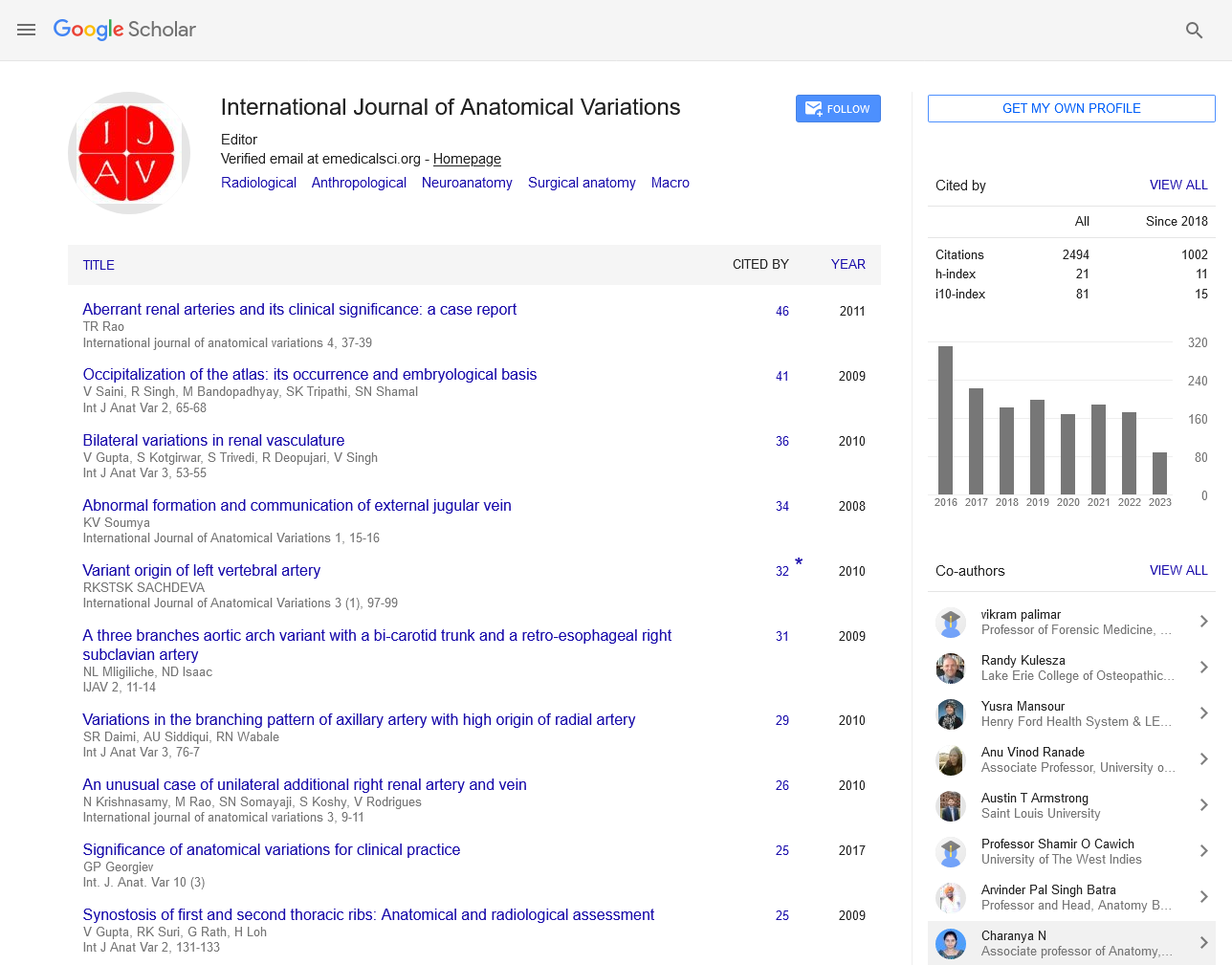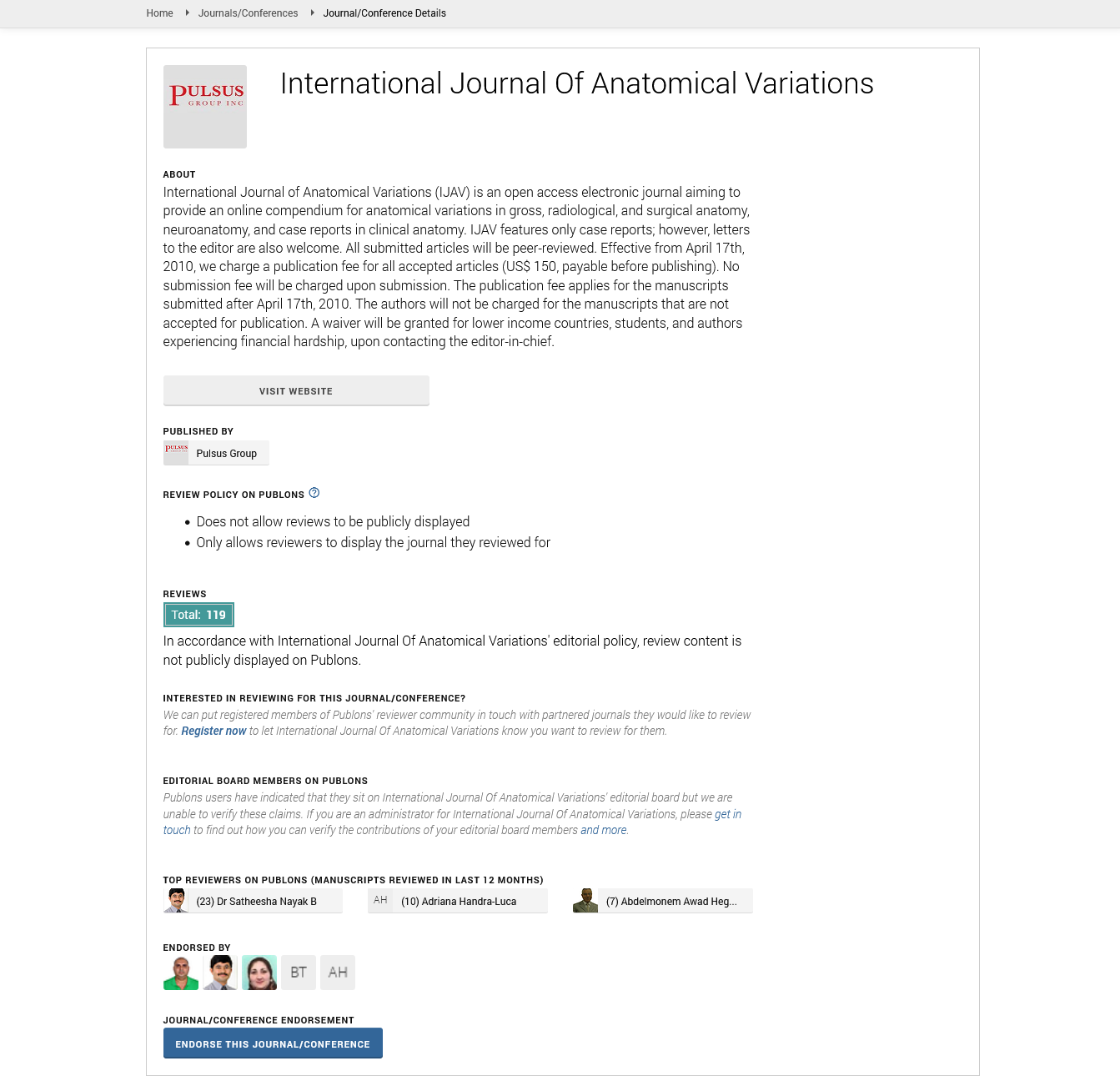Anatomical Variations of the Great Vessels: Implications for Cardiac Surgery and Aortic Pathology
Received: 02-Dec-2024, Manuscript No. ijav-24-7355; Editor assigned: 04-Dec-2024, Pre QC No. ijav-24-7355 (PQ); Reviewed: 18-Dec-2024 QC No. ijav-24-7355; Revised: 26-Dec-2024, Manuscript No. ijav-24-7355 (R); Published: 31-Dec-2024, DOI: 10.37532/1308-4038.17(12).462
Citation: Kruger A. Anatomical Variations of the Great Vessels Implications for Cardiac Surgery and Aortic Pathology. Int J Anat Var. 2024;17(12): 693-694.
This open-access article is distributed under the terms of the Creative Commons Attribution Non-Commercial License (CC BY-NC) (http://creativecommons.org/licenses/by-nc/4.0/), which permits reuse, distribution and reproduction of the article, provided that the original work is properly cited and the reuse is restricted to noncommercial purposes. For commercial reuse, contact reprints@pulsus.com
Abstract
Anatomical variations of the great vessels, including the aorta and its major branches, represent a significant challenge in both cardiac surgery and the management of aortic pathology. While the standard anatomical configuration of the aorta and its branches is well-established, variations in the branching patterns, origins, and course of the great vessels can lead to complications during surgical interventions, diagnostic imaging, and the management of aortic diseases. This article explores the various anatomical variations of the great vessels, such as aberrant right subclavian arteries, coarctation of the aorta, and double aortic arches, and discusses their implications for cardiac surgery, aortic aneurysms, and other aortic pathologies. Understanding these variations is critical for improving surgical outcomes, facilitating accurate diagnosis, and providing personalized treatment plans in patients with these unusual vascular anatomies.
INTRODUCTION
The great vessels, which include the aorta, pulmonary arteries, and their major branches, form the central vascular structures of the cardiovascular system. The aorta, being the largest artery in the body, originates from the left ventricle and serves as the primary conduit for oxygenated blood to the systemic circulation. Its branching pattern typically includes the brachiocephalic trunk, left common carotid artery, and left subclavian artery, all of which are essential for supplying blood to the head, neck, and upper extremities. Although most individuals have a typical anatomical configuration, significant variations in the great vessels occur in a substantial percentage of the population. These variations can arise as congenital anomalies or as a result of pathological processes affecting the aorta. Such anatomical differences pose challenges during both diagnostic and therapeutic interventions, particularly in the context of cardiac surgery and aortic pathologies, where precise vascular anatomy is crucial. Anomalies such as aberrant arteries, vascular malformations, or abnormal branching patterns can complicate surgical procedures and interfere with accurate diagnosis, requiring tailored approaches to patient care [1].
ANATOMY OF THE GREAT VESSELS
The aorta and its major branches are typically organized into several sections, including the ascending aorta, aortic arch, descending aorta, and abdominal aorta. The ascending aorta arises directly from the left ventricle and is connected to the aortic arch, which curves over the heart and supplies blood to the head, neck, and upper limbs. The three primary branches of the aortic arch in most individuals are the brachiocephalic trunk, left common carotid artery, and left subclavian artery. After the arch, the aorta continues as the descending aorta, which is divided into the thoracic and abdominal portions. The vascular anatomy of the great vessels is generally standardized in most people; however, the presence of anatomical variations can alter the structure and function of these vessels. Variations can occur in the origin, number, size, and trajectory of the branches from the aorta, and they may significantly affect blood flow to critical organs and tissues [2].
TYPES OF ANATOMICAL VARIATIONS OF THE GREAT VESSELS
Anatomical variations of the great vessels can take several forms, ranging from minor deviations in vessel size or shape to more complex and rare malformations that affect the entire arterial system. Some of the most common and clinically significant variations include
Aberrant Right Subclavian Artery (ARSA)
The aberrant right subclavian artery (ARSA) is one of the most common congenital vascular anomalies and occurs in approximately 0.5% to 2% of the population [3]. In this condition, the right subclavian artery arises from the descending aorta rather than from the brachiocephalic trunk, resulting in an unusual and often elongated path to the right upper extremity [4]. The aberrant artery may pass posterior to the esophagus, leading to potential compression of the esophagus and, in rare cases, dysphagia, a condition known as "dysphagia lusoria." In cardiac surgery, the presence of an ARSA may complicate procedures such as coronary artery bypass grafting (CABG) or aortic valve replacement, as surgeons must take extra precautions to avoid injuring the aberrant artery. Additionally, ARSA is associated with a higher incidence of other vascular anomalies, such as aortic coarctation, which may further complicate treatment [5].
Coarctation of the Aorta
Coarctation of the aorta (CoA) is a congenital narrowing of the aorta that most commonly occurs just distal to the origin of the left subclavian artery. This narrowing leads to increased resistance in the aortic arch, resulting in hypertension in the upper extremities and reduced perfusion to the lower body. CoA can present with a variety of symptoms, ranging from asymptomatic to life-threatening, and it often requires surgical intervention, either through resection and anastomosis or through balloon angioplasty. Coarctation is often associated with other congenital anomalies, including bicuspid aortic valve and abnormalities in the branching of the aortic arch. Surgical repair of coarctation requires careful attention to the anatomy of the aortic arch and the great vessels, as variations in branching patterns can complicate the procedure and affect outcomes [6].
Double Aortic Arch
A double aortic arch is a rare congenital anomaly where the aortic arch forms two separate branches that encircle the trachea and esophagus. This condition leads to the compression of both the airway and the esophagus, causing symptoms such as stridor, respiratory distress, and difficulty swallowing. The double aortic arch is typically diagnosed in infancy or early childhood, though it may be detected incidentally in adults undergoing imaging for other conditions. In surgical treatment, the key is to identify which of the two arches is responsible for compressing the trachea and esophagus. Surgical division of the non-compressive arch is the standard approach, and understanding the precise anatomical configuration of the arch is essential to avoiding injury to critical structures during the procedure [7].
Left-sided Aortic Arch with Anomalous Branches
In some patients, the aortic arch may have an abnormal branching pattern, with one or more vessels arising from atypical positions. For example, the right common carotid artery may arise directly from the aortic arch rather than from the brachiocephalic trunk. Such variations can result in abnormal blood flow dynamics and complicate both diagnostic and therapeutic procedures. In cases of aortic surgery or coronary artery bypass grafting, knowledge of these anomalous vessels is critical to prevent inadvertent injury.
Aortic Arch Hypoplasia
Aortic arch hypoplasia refers to the underdevelopment or narrowing of the aortic arch and is often associated with other congenital heart defects such as hypoplastic left heart syndrome. This condition can result in significant hemodynamic consequences, including impaired blood flow to the brain and upper body. In such cases, surgical interventions such as staged palliation or heart transplantation may be required, with careful consideration of the associated vascular anomalies [8].
IMPLICATIONS FOR CARDIAC SURGERY
Anatomical variations of the great vessels are of paramount importance in cardiac surgery. Surgical procedures such as coronary artery bypass grafting, aortic valve replacement, and aortic dissection repair can be complicated by unexpected vascular anomalies. Surgeons must be familiar with potential variations in the vascular anatomy to avoid intraoperative complications, such as accidental arterial injury, incorrect graft placement, or inadequate blood supply to critical organs. For example, during aortic dissection repair, the precise identification of the true and false lumens in aortic dissection, as well as the proper identification of arterial branches, can be difficult in patients with anomalous aortic anatomy. In patients with an aberrant right subclavian artery, the vascular configuration may necessitate alternative surgical approaches or the use of specialized imaging techniques to ensure safe and effective treatment [9].
IMPLICATIONS FOR AORTIC PATHOLOGY
Aortic pathology, including aneurysms, dissections, and atherosclerosis, can also be complicated by variations in the great vessels. For instance, in patients with an aberrant right subclavian artery or a double aortic arch, aneurysms may form in unusual locations, complicating both diagnosis and surgical management. In such cases, imaging techniques such as CT angiography, MRI, or 3D reconstruction are essential for obtaining a clear view of the anatomy and planning the appropriate intervention. Moreover, patients with congenital anomalies of the aortic arch may be at increased risk for developing aortic pathologies later in life, such as aneurysms or dissections, particularly if the variations are associated with abnormal hemodynamic stress or turbulent blood flow [10].
CONCLUSION
Anatomical variations of the great vessels, though relatively rare, have important implications for cardiac surgery and the management of aortic pathologies. These variations, such as aberrant right subclavian arteries, coarctation of the aorta, and double aortic arches, require heightened awareness during diagnostic evaluation and surgical intervention. Understanding these variations is critical for preventing complications and optimizing patient outcomes. As imaging techniques continue to advance and our understanding of vascular anomalies deepens, it is likely that more tailored and personalized treatment approaches will become standard in managing patients with these unusual vascular anatomies.
REFERENCES
Indexed at, Google Scholar, Crossref
Indexed at, Google Scholar, Crossref
Indexed at, Google Scholar, Crossref
Indexed at, Google Scholar, Crossref
Indexed at, Google Scholar, Crossref
Indexed at, Google Scholar, Crossref
Indexed at, Google Scholar, Crossref
Indexed at, Google Scholar, Crossref
- Bleich AT, Rahn DD, Wieslander CK, Wai CY, Roshanravan SM, et al. Posterior division of the internal iliac artery: Anatomic variations and clinical applications. Am J Obstet Gynecol. 2007; 197:658.e651-658.e655.
- Park K-M, Yang S-S, Kim Y-W, Park KB, Park HS, et al. Clinical outcomes after internal iliac artery embolization prior to endovascular aortic aneurysm repair. Surg Today 2014; 44:472-477.
- Fontana F, Coppola A, Ferrario L. Internal Iliac Artery Embolization within EVAR Procedure: Safety, Feasibility, and Outcome. J Clin Med. 2022; 11(24):73-99.
- Osher M, Semaan D, Osher D. The uterine arteries, anatomic variation and the implications pertaining to uterine artery embolization. J Vasc Interv Radiol 2014; 25:S143.
- Rayt HS, Bown MJ, Lambert KV. Buttock claudication and erectile dysfunction after internal iliac artery embolization in patients prior to endovascular aortic aneurysm repair. Cardiovasc Intervent Radiol. 2008; 31(4):728-34.
- Szymczak M, Krupa P, Oszkinis G, Majchrzycki M. Gait pattern in patients with peripheral artery disease. BMC Geriatrics. 2018; 18:52.
- Chase J. Variation in the Branching Pattern of the Internal Iliac Artery. In: University of North Texas Health Science Center. Fort Worth. 2016: 1-33.
- Nayak SB, Shetty P, Surendran S, Shetty SD. Duplication of Inferior Gluteal Artery and Course of Superior Gluteal Artery Through the Lumbosacral Trunk. OJHAS. 2017; 16.
- Albulescu D, Constantin C, Constantin C. Uterine artery emerging variants - angiographic aspects. Current Health Sciences Journal 2014; 40:214-216.
- Patel SD, Perera A, Law N, Mandumula S. A novel approach to the management of a ruptured Type II endoleak following endovascular repair of an internal iliac artery aneurysm. Br J Radiol. 2011; 84(1008):e240-242.






